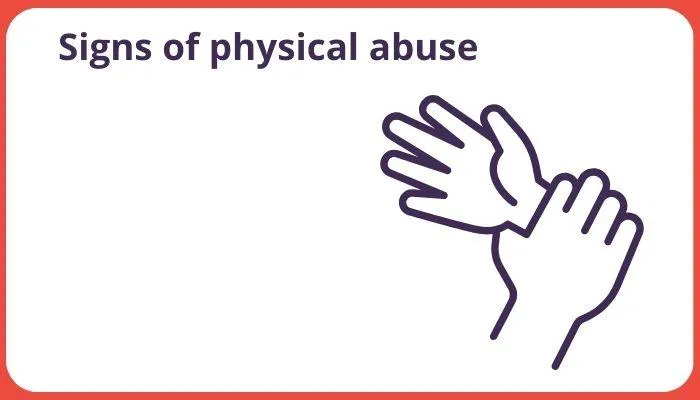Every child's well-being matters.
Types of Abuse Articles
Quick Access
Abuse of Authority
Abuse of Discretion
Abuse of Power
Behavioural Indications
Breast Ironing
County Lines
Cultural Differences (Physical Abuse)
Domestic Abuse
Economic Abuse
Emotional Signs
Exposure to Substance Abuse
Failure to Thrive
Female Genital Mutilation (FGM)
Forced Marriage
Hate Crimes & Targeted Harassment
Impact of Domestic Violence
Impact of Environment
Impact on Development
Institutional Abuse
Isolation
Modern Slavery
Neglect
Online Abuse
Parental Behaviours
Physical Abuse
Radicalisation
Religious Abuse
Restraint
Sexual Abuse
Types of Abuse
Witnessing Domestic Abuse

What are the signs of physical abuse?
Among the different ways abuse can manifest, physical abuse is vital to notice. Adults must recognise and respond to the signs in a way that's both professional and accessible.
Firstly, unexplained injuries are a clear indicator of potential physical abuse. If a child has bruises, cuts, or burns without clear explanations, especially if they happen repeatedly or in specific areas like the face, arms, or torso, it should raise immediate concern. Consistent and unexplained injuries need further investigation.
In cases of physical abuse, a recurring theme is the repetition of injuries accompanied by vague explanations. If a child or parent consistently gives different or unclear reasons for injuries, it's a significant red flag. Despite changing stories, the consistency of the type and location of injuries suggests an ongoing problem that requires investigation. Another sign is a delay in seeking medical attention for a child's injuries. When caregivers hesitate or avoid prompt medical care, it may indicate an effort to conceal the actual cause, raising serious concerns about the child's well-being.
Distinct injury patterns, like belt marks or burns shaped like objects, often indicate intentional harm. Recognising these patterns is crucial, as they provide important clues about the nature of the abuse and help professionals assess the severity of the situation.
Considering a child's developmental stage is crucial when evaluating injuries. If the nature of the injuries doesn't match what is typical for their age, like fractures in a non-walking infant, it becomes a clear indication of potential abuse. The mismatch between the child's developmental capabilities and observed injuries should prompt further investigation.
Beyond physical indicators, changes in a child's behaviour due to pain can be telling signs of abuse. A child who goes from being happy and playful to withdrawn or irritable may be experiencing physical discomfort. Understanding these behavioural changes, especially with visible injuries, is crucial for early intervention. Frequent hospitalisations for similar injuries are another concerning sign. Multiple hospital visits for the same type of injuries indicate a recurring issue that needs immediate attention and intervention to break the cycle of abuse.
AUTHOR:- Iona has nearly 10 years of experience supporting nurseries and childminders in curriculum planning, leadership, and safeguarding. Her writing is informed by public information and sector insight, aiming to provide accessible, practical support for professionals working with children. She is part of the On the Button team, helping deliver Well-being, Safeguarding and Complaint Management Software that empowers practitioners to identify concerns early and act confidently.
On the Button provides innovative software tailored to the needs of the early years sector, with a strong focus on EYFS well-being and early years safeguarding. Our tools help senior practitioners to confidently track concerns, maintain robust records, and respond effectively — all while meeting statutory guidance. From early years complaint management to team-wide safeguarding alerts, our platform puts children's safety and emotional health first.
Quick Access
Abuse of Authority
Abuse of Discretion
Abuse of Power
Behavioural Indications
Breast Ironing
County Lines
Cultural Differences (Physical Abuse)
Domestic Abuse
Economic Abuse
Emotional Signs
Exposure to Substance Abuse
Failure to Thrive
Female Genital Mutilation (FGM)
Forced Marriage
Hate Crimes & Targeted Harassment
Impact of Domestic Violence
Impact of Environment
Impact on Development
Institutional Abuse
Isolation
Modern Slavery
Neglect
Online Abuse
Parental Behaviours
Physical Abuse
Radicalisation
Religious Abuse
Restraint
Sexual Abuse
Types of Abuse
Witnessing Domestic Abuse

What are the signs of physical abuse?
Among the different ways abuse can manifest, physical abuse is vital to notice. Adults must recognise and respond to the signs in a way that's both professional and accessible.
Firstly, unexplained injuries are a clear indicator of potential physical abuse. If a child has bruises, cuts, or burns without clear explanations, especially if they happen repeatedly or in specific areas like the face, arms, or torso, it should raise immediate concern. Consistent and unexplained injuries need further investigation.
In cases of physical abuse, a recurring theme is the repetition of injuries accompanied by vague explanations. If a child or parent consistently gives different or unclear reasons for injuries, it's a significant red flag. Despite changing stories, the consistency of the type and location of injuries suggests an ongoing problem that requires investigation. Another sign is a delay in seeking medical attention for a child's injuries. When caregivers hesitate or avoid prompt medical care, it may indicate an effort to conceal the actual cause, raising serious concerns about the child's well-being.
Distinct injury patterns, like belt marks or burns shaped like objects, often indicate intentional harm. Recognising these patterns is crucial, as they provide important clues about the nature of the abuse and help professionals assess the severity of the situation.
Considering a child's developmental stage is crucial when evaluating injuries. If the nature of the injuries doesn't match what is typical for their age, like fractures in a non-walking infant, it becomes a clear indication of potential abuse. The mismatch between the child's developmental capabilities and observed injuries should prompt further investigation.
Beyond physical indicators, changes in a child's behaviour due to pain can be telling signs of abuse. A child who goes from being happy and playful to withdrawn or irritable may be experiencing physical discomfort. Understanding these behavioural changes, especially with visible injuries, is crucial for early intervention. Frequent hospitalisations for similar injuries are another concerning sign. Multiple hospital visits for the same type of injuries indicate a recurring issue that needs immediate attention and intervention to break the cycle of abuse.
AUTHOR:- Iona has nearly 10 years of experience supporting nurseries and childminders in curriculum planning, leadership, and safeguarding. Her writing is informed by public information and sector insight, aiming to provide accessible, practical support for professionals working with children. She is part of the On the Button team, helping deliver Well-being, Safeguarding and Complaint Management Software that empowers practitioners to identify concerns early and act confidently.
On the Button provides innovative software tailored to the needs of the early years sector, with a strong focus on EYFS well-being and early years safeguarding. Our tools help senior practitioners to confidently track concerns, maintain robust records, and respond effectively — all while meeting statutory guidance. From early years complaint management to team-wide safeguarding alerts, our platform puts children's safety and emotional health first.

What are the signs of physical abuse?
Among the different ways abuse can manifest, physical abuse is vital to notice. Adults must recognise and respond to the signs in a way that's both professional and accessible.
Firstly, unexplained injuries are a clear indicator of potential physical abuse. If a child has bruises, cuts, or burns without clear explanations, especially if they happen repeatedly or in specific areas like the face, arms, or torso, it should raise immediate concern. Consistent and unexplained injuries need further investigation.
In cases of physical abuse, a recurring theme is the repetition of injuries accompanied by vague explanations. If a child or parent consistently gives different or unclear reasons for injuries, it's a significant red flag. Despite changing stories, the consistency of the type and location of injuries suggests an ongoing problem that requires investigation. Another sign is a delay in seeking medical attention for a child's injuries. When caregivers hesitate or avoid prompt medical care, it may indicate an effort to conceal the actual cause, raising serious concerns about the child's well-being.
Distinct injury patterns, like belt marks or burns shaped like objects, often indicate intentional harm. Recognising these patterns is crucial, as they provide important clues about the nature of the abuse and help professionals assess the severity of the situation.
Considering a child's developmental stage is crucial when evaluating injuries. If the nature of the injuries doesn't match what is typical for their age, like fractures in a non-walking infant, it becomes a clear indication of potential abuse. The mismatch between the child's developmental capabilities and observed injuries should prompt further investigation.
Beyond physical indicators, changes in a child's behaviour due to pain can be telling signs of abuse. A child who goes from being happy and playful to withdrawn or irritable may be experiencing physical discomfort. Understanding these behavioural changes, especially with visible injuries, is crucial for early intervention. Frequent hospitalisations for similar injuries are another concerning sign. Multiple hospital visits for the same type of injuries indicate a recurring issue that needs immediate attention and intervention to break the cycle of abuse.
AUTHOR:- Iona has nearly 10 years of experience supporting nurseries and childminders in curriculum planning, leadership, and safeguarding. Her writing is informed by public information and sector insight, aiming to provide accessible, practical support for professionals working with children. She is part of the On the Button team, helping deliver Well-being, Safeguarding and Complaint Management Software that empowers practitioners to identify concerns early and act confidently.
On the Button provides innovative software tailored to the needs of the early years sector, with a strong focus on EYFS well-being and early years safeguarding. Our tools help senior practitioners to confidently track concerns, maintain robust records, and respond effectively — all while meeting statutory guidance. From early years complaint management to team-wide safeguarding alerts, our platform puts children's safety and emotional health first.
Quality Early Years Ltd.,
Dickens House,
Guithavon Street,
Witham, Essex,
England, CM8 1BJ
© Quality Early Years Ltd 2025
On the Button are Finalists for 3/3 Early Years Awards!
Find On the Button
on Social Media

